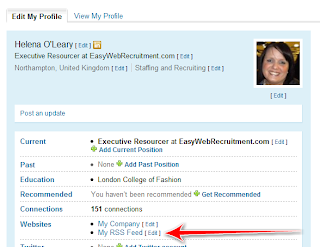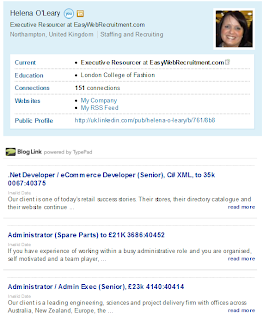Well if you post vacancies on Linkedin ($195 a posting) then they will show up in your linkedin profile.

They will also show up on your company page.
 As part of the research, we were keen to devise a way of having your latest jobs feed into your profile so that anyone viewing your profile can leap straight to your careers site if a vacancy catches their eye. Once again this is a long range tactic that will eventually pay off so you don't want to have to keep updating / tweaking your profile. Keep the input (your time) to a minimum, then you are under less pressure to deliver a quantifiable output (hires/applications).
As part of the research, we were keen to devise a way of having your latest jobs feed into your profile so that anyone viewing your profile can leap straight to your careers site if a vacancy catches their eye. Once again this is a long range tactic that will eventually pay off so you don't want to have to keep updating / tweaking your profile. Keep the input (your time) to a minimum, then you are under less pressure to deliver a quantifiable output (hires/applications).Step 1 - Get an RSS feed from your Applicant Tracking Software Vendor (Recruitment Software)
If you don't have an ATS provider then you will probably not be able to take advantage of this method. But we use Hireserve and I would recommend them highly (we like them so much we actually partnered with them to sell their products to our clients).
Our RSS feed is: http://jobs.easywebrecruitment.com/rss.xml
Step 2 -Add the RSS feed as a listed website under "MyRSS Feed"
Select to edit your profile. Then select to edit the websites that are listed under your profile.

Then choose "MyRSS Feed" and input your RSS feed.

Step 3 - Viola!
Your vacancies will automatically appear in your profile.

Those of you who are very clever will realise that although this method does work there is a small problem in that our RSS feed is not listing our most recent roles but its listing them alphabetically. Do not fret. Your RSS feed should be able to list them in date order, we have already raised this with Hireserve and a quick fix will be in place soon.
NEXT WEEK
Next week we will show you the second half of this strategy including how to get your vacancies automatically listing in your company page for zero effort. Watch this space....





